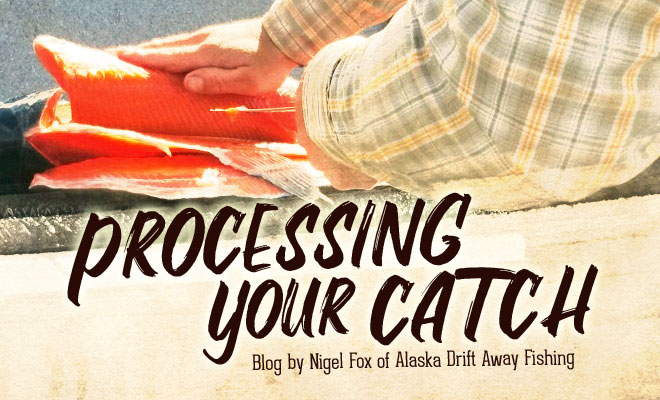 How to process fresh salmon
How to process fresh salmon
Processing your fresh salmon at the end of the day can be a daunting task, especially if you have a lot of other things to do. However, it is probably the single, most-important thing you can do to ensure quality. A few things need to happen on the river and at home to ensure your catch is preserved and ready for the freezer.
One thing I have noticed from my many years of guiding for salmon is how important it is to take care of your fish once you have landed them. Gilling your fish immediately and letting the salmon bleed out ensures that the meat will not be bloody when filleting them at the end of the day. I like to land the salmon in a net, then bonk them. You don’t want them flopping around while trying to use a knife to gill them. Personally, I like to use a pair of heavy-duty scissors and cut both sides of the gills.
Once you’ve dispatched and bled the fish, keeping your catch cold throughout the day is very important. If I am on the shore fishing, I will keep my fish on a stringer in the river, and if I am fishing in a boat then my catch is in a fish box so I can dump fresh water from the river over them ever hour. Whatever your method, keeping the salmon cold makes the meat stay firm and helps prevent spoilage; the other benefit is your fish will be easier to fillet.
Before filleting your salmon at the end of the day you, should be really meticulous. I will wash all the blood off the outside side of the fish, try to wipe most of the fish slime off and then fillet the fish on a clean surface. Once I fillet one side, the fillet immediately goes in a bag and does not touch any water or debris. Washing your salmon fillet off in the river is a bad idea; it can wash some of the oils out of the meat and could potentially add bacteria onto your fresh salmon. If you get blood on the meat when you are filleting, just wipe it off with your hand or a towel. The next step is to get your fresh-filleted salmon on ice until you can process it. Keeping fish cold is very important so it doesn’t spoil. I generally throw some ice in a cooler in the morning and when I get back it will be nice and cold for your catch.
Once you’re home, the real work begins. The sooner you can process your salmon and get them in the freezer, the better. I usually have a large, clean table; a vacuum sealer and quart-sized vacuum sealer bags that I use to package the fish. If you can have an assembly line of people to help it speeds the process and gets your fish in the freezer faster.
First, I cut my fillets into meal-sized portions. I like to pat the fillet dry before putting it in the vacuum seal bag. I center the fillet in the bag before vacuum sealing because that ensures it gets vacuumed all the way around and seals correctly. After the salmon fillets are sealed in individual bags, I inspect each bag to make sure it is holding a good seal. Once you have done your inspection it is important to lay all packaged fish flat, in a single layer if possible, so it freezes quickly. The faster it freezes, the better the quality. Laying the fish flat will help ensure that it stays vacuum-sealed. A single layer will also freeze faster than if you have several layers of fish on the rack.
This is only one way to preserve your fresh salmon, but it has been very effective for me. Following this process will cut down on the amount of spoiled or freezer-burned fish you might otherwise have. It seems like a long process, but when you go to open a package of fish to cook in the winter, you will thank me.
Nigel Fox has been partners with Jeremy Anderson and Nick Ohlrich at Alaska Drift Away Fishing for over a decade. He is a lifelong Alaskan and has been fishing on the Kenai River since he was a young boy, and each year he learns more about the intricate world of catching trophy fish on the Kenai and Kasilof rivers.
